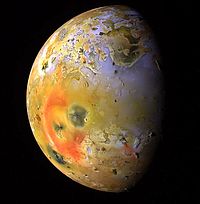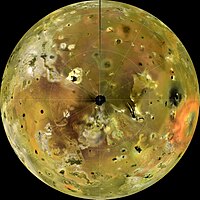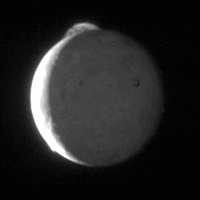Solar System, technical/Io

| Completion status: this resource is just getting off the ground. Please feel welcome to help! |
Io is a rocky-object that is irradiated by the Sun.
| Development status: this resource is experimental in nature. |
| Educational level: this is a primary education resource. |
| Educational level: this is a secondary education resource. |
| Educational level: this is a tertiary (university) resource. |
| Educational level: this is a research resource. |
| Type classification: this is an article resource. |
| Resource type: this resource contains a lecture or lecture notes. |
| Subject classification: this is an astronomy resource. |
Notation[edit | edit source]
Notation: let the symbol Def. indicate that a definition is following.
Notation: let the symbols between [ and ] be replacement for that portion of a quoted text.
Notation: let the symbol ... indicate unneeded portion of a quoted text.
Sometimes these are combined as [...] to indicate that text has been replaced by ....
Universals[edit | edit source]
Def. a "characteristic or property that particular things have in common"[1] is called a universal.
"When we examine common words, we find that, broadly speaking, proper names stand for particulars, while other substantives, adjectives, prepositions, and verbs stand for universals."[2]
Such words as "entity", "object", "thing", and perhaps "body", words "connoting universal properties, ... constitute the very highest genus or "summum genus"" of a classification of universals.[3] To propose a definition for say a plant whose flowers open at dawn on a warm day to be pollinated during the day time using the word "thing", "entity", "object", or "body" seems too general and is.
To help with definitions, their meanings and intents, there is the learning resource theory of definition.
Proof of concept[edit | edit source]
Def. a “short and/or incomplete realization of a certain method or idea to demonstrate its feasibility"[4] is called a proof of concept.
Def. evidence that demonstrates that a concept is possible is called proof of concept.
The proof-of-concept structure consists of
- background,
- procedures,
- findings, and
- interpretation.[5]
Control groups[edit | edit source]

The findings demonstrate a statistically systematic change from the status quo or the control group.
“In the design of experiments, treatments [or special properties or characteristics] are applied to [or observed in] experimental units in the treatment group(s).[6] In comparative experiments, members of the complementary group, the control group, receive either no treatment or a standard treatment.[7]"[8]
Astronomy[edit | edit source]
Planetary science[edit | edit source]
Colors[edit | edit source]
Minerals[edit | edit source]
Entities[edit | edit source]
Sources[edit | edit source]
Objects[edit | edit source]
Strong forces[edit | edit source]
Electromagnetics[edit | edit source]
Weak forces[edit | edit source]
Continuum[edit | edit source]
Emissions[edit | edit source]
Absorptions[edit | edit source]
Bands[edit | edit source]
Background[edit | edit source]
Meteors[edit | edit source]
Cosmic rays[edit | edit source]
Neutrals[edit | edit source]
Neutrons[edit | edit source]
Protons[edit | edit source]
Beta particles[edit | edit source]
Electrons[edit | edit source]
Positrons[edit | edit source]
Muons[edit | edit source]
Neutrinos[edit | edit source]
Gamma rays[edit | edit source]
X-rays[edit | edit source]
Ultraviolets[edit | edit source]
Opticals[edit | edit source]
Visuals[edit | edit source]
Violets[edit | edit source]
Blues[edit | edit source]
Cyans[edit | edit source]
Greens[edit | edit source]

At right is an "eerie view of Jupiter's moon Io in eclipse ... acquired by NASA's Galileo spacecraft while the moon was in Jupiter's shadow. Gases above the satellite's surface produced a ghostly glow that could be seen at visible wavelengths (red, green, and violet). The vivid colors, caused by collisions between Io's atmospheric gases and energetic charged particles trapped in Jupiter's magnetic field, had not previously been observed. The green and red emissions are probably produced by mechanisms similar to those in Earth's polar regions that produce the aurora, or northern and southern lights. Bright blue glows mark the sites of dense plumes of volcanic vapor, and may be places where Io is electrically connected to Jupiter."[9]
"North is to the top of the picture, and Jupiter is towards the right. The resolution is 13.5 kilometers (8 miles) per picture element. The images were taken on May 31, 1998 at a range of 1.3 million kilometers (800,000 miles) by Galileo's onboard solid state imaging camera system during the spacecraft's 15th orbit of Jupiter."[9]
Yellows[edit | edit source]





Io "is the innermost of the four Galilean moons of the planet Jupiter and, with a diameter of 3,642 kilometres (2,263 mi), the fourth-largest moon in the Solar System. ... With over 400 active volcanoes, Io is the most geologically active object in the Solar System.[10][11] ... Most of Io's surface is characterized by extensive plains coated with sulfur and sulfur dioxide frost. ... Io's volcanism is responsible for many of the satellite's unique features. Its volcanic plumes and lava flows produce large surface changes and paint the surface in various shades of yellow, red, white, black, and green, largely due to allotropes and compounds of sulfur."[12]
In the image at right, "[t]he smallest features that can be discerned are 2.5 kilometers in size. There are rugged mountains several kilometers high, layered materials forming plateaus, and many irregular depressions called volcanic calderas. Several of the dark, flow-like features correspond to hot spots, and may be active lava flows. There are no landforms resembling impact craters, as the volcanism covers the surface with new deposits much more rapidly than the flux of comets and asteroids can create large impact craters. The picture is centered on the side of Io that always faces away from Jupiter; north is to the top."[13]
"Color images acquired on September 7, 1996 have been merged with higher resolution images acquired on November 6, 1996 by the Solid State Imaging (CCD) system aboard NASA's Galileo spacecraft. The color is composed of data taken, at a range of 487,000 kilometers, in the near-infrared, green, and violet filters and has been enhanced to emphasize the extraordinary variations in color and brightness that characterize Io's face. The high resolution images were obtained at ranges which varied from 245,719 kilometers to 403,100 kilometers."[13]
The second image at right is a "global view of Jupiter's moon, Io, ... obtained during the tenth orbit of Jupiter by NASA's Galileo spacecraft. Io, which is slightly larger than Earth's moon, is the most volcanically active body in the solar system. In this enhanced color composite, deposits of sulfur dioxide frost appear in white and grey hues while yellowish and brownish hues are probably due to other sulfurous materials. Bright red materials, such as the prominent ring surrounding Pele, and "black" spots with low brightness mark areas of recent volcanic activity and are usually associated with high temperatures and surface changes. One of the most dramatic changes is the appearance of a new dark spot (upper right edge of Pele), 400 kilometers (250 miles)in diameter which surrounds a volcanic center named Pillan Patera. The dark spot did not exist in images obtained 5 months earlier, but Galileo imaged a 120 kilometer (75 mile) high plume erupting from this location during its ninth orbit. North is to the top of the picture which was taken on September 19, 1997 at a range of more than 500,000 kilometers (310,000 miles) by the Solid State Imaging (SSI) system on NASA's Galileo spacecraft."[14]
The third image at right continues around Io to the left.
The fourth image is of Io's north pole. "[The] new basemap [and the polar images] of Jupiter's moon Io was produced by combining the best images from both the Voyager 1 and Galileo Missions. Although the subjovian hemisphere of Io was poorly seen by Galileo, superbly detailed Voyager 1 images cover longitudes from 240 W to 40 W and the nearby southern latitudes. A monochrome mosaic of the highest resolution images from both Galileo and Voyager 1 was assembled that includes 51 Voyager 1 images with spatial resolutions sometimes exceeding the 1 km/pixel scale of the final mosaic. Because this mosaic is made up of images taken at various local times of day, care must be taken to note the solar illumination direction when deciding whether topographic features display positive or negative relief. In general, the illumination is from the west over longitudes 40 to 270 W, and from the east over longitudes 270 W to 40 W. Color information was later superimposed from Galileo low phase angle violet, green, and near-infrared (756 nanometer wavelength) images. The Galileo SSI camera's silicon CCD was sensitive to longer wavelengths than the vidicon cameras of Voyager, so that distinctions between red and yellow hues can be more easily discerned. The "true" colors that would be visible to the eye are similar but much more muted than shown here. Image resolutions range from 1 to 10 km/pixel along the equator, with the poorest coverage centered on longitude 50 W."[15]
The fifth image is of Io's south pole.
The last image is an animated image showing a 1 Io day of rotation. "In the same way that the Moon always has the same side facing Earth, Io always has the same side facing Jupiter. The movie shows two speeded-up rotations of Io (a single rotation really takes 1.77 days), and begins with a view of the Jupiter-facing hemisphere. With rotation in an easterly direction, after two seconds the volcano Prometheus (on the equator) comes into view. The massive red deposit around Pele (seconds 5-10) is the most distinctive expression of volcanic activity on Io, and just to the north-west is the horse shoe-shaped Loki Patera, the most powerful volcano on Io. The animation was made using a computer program that wrapped the Io mosaic around a sphere to produce a globe. In all, 360 images were used, each differing by one degree in longitude from the previous image."[16]
Oranges[edit | edit source]
Reds[edit | edit source]
Infrareds[edit | edit source]
Submillimeters[edit | edit source]
Microwaves[edit | edit source]
Radars[edit | edit source]
Radios[edit | edit source]
Superluminals[edit | edit source]
Subatomics[edit | edit source]
Plasma objects[edit | edit source]
Gaseous objects[edit | edit source]
Liquid objects[edit | edit source]
Rocky objects[edit | edit source]
Astrochemistry[edit | edit source]
Hydrogen[edit | edit source]
Helium[edit | edit source]
Lithium[edit | edit source]
Beryllium[edit | edit source]
Boron[edit | edit source]
Carbon[edit | edit source]
Nitrogen[edit | edit source]
Oxygen[edit | edit source]
Fluorine[edit | edit source]
Neon[edit | edit source]
Ions[edit | edit source]
Compounds[edit | edit source]
Alloys[edit | edit source]
Atmospheres[edit | edit source]
Materials[edit | edit source]
Meteorites[edit | edit source]
Shelters[edit | edit source]
Spectroscopy[edit | edit source]
Spectrometers[edit | edit source]
Craters[edit | edit source]



Geography[edit | edit source]
History[edit | edit source]
Mathematics[edit | edit source]
Physics[edit | edit source]
Science[edit | edit source]
Technology[edit | edit source]
See also[edit | edit source]
References[edit | edit source]
- ↑ "universal, In: Wiktionary". San Francisco, California: Wikimedia Foundation, Inc. May 28, 2014. Retrieved 2014-06-04.
- ↑ Bertrand Russel (1912). Chapter 9, In: The Problems of Philosophy.
- ↑ Irving M. Copi (1955). Introduction to Logic. New York: The MacMillan Company. pp. 472.
- ↑ "proof of concept, In: Wiktionary". San Francisco, California: Wikimedia Foundation, Inc. November 10, 2012. Retrieved 2013-01-13.
- ↑ Ginger Lehrman and Ian B Hogue, Sarah Palmer, Cheryl Jennings, Celsa A Spina, Ann Wiegand, Alan L Landay, Robert W Coombs, Douglas D Richman, John W Mellors, John M Coffin, Ronald J Bosch, David M Margolis (August 13, 2005). "Depletion of latent HIV-1 infection in vivo: a proof-of-concept study". Lancet 366 (9485): 549-55. doi:10.1016/S0140-6736(05)67098-5. http://www.sciencedirect.com/science/article/pii/S0140673605670985. Retrieved 2012-05-09.
- ↑ Klaus Hinkelmann, Oscar Kempthorne (2008). Design and Analysis of Experiments, Volume I: Introduction to Experimental Design (2nd ed.). Wiley. ISBN 978-0-471-72756-9. http://books.google.com/?id=T3wWj2kVYZgC&printsec=frontcover.
- ↑ R. A. Bailey (2008). Design of comparative experiments. Cambridge University Press. ISBN 978-0-521-68357-9. http://www.maths.qmul.ac.uk/~rab/DOEbook/.
- ↑ "Treatment and control groups, In: Wikipedia". San Francisco, California: Wikimedia Foundation, Inc. May 18, 2012. Retrieved 2012-05-31.
- ↑ 9.0 9.1 Sue Lavoie (October 13, 1998). "PIA01637: Io's Aurorae". Pasadena, California: NASA and the Jet Propulsion Laboratory, California Institute of Technology. Retrieved 2012-07-22.
- ↑ Rosaly MC Lopes (2006). "Io: The Volcanic Moon". In Lucy-Ann McFadden. Encyclopedia of the Solar System. Academic Press. pp. 419–431. ISBN 978-0-12-088589-3.
- ↑ R. M. C. Lopes et al. (2004). "Lava lakes on Io: Observations of Io’s volcanic activity from Galileo NIMS during the 2001 fly-bys". Icarus 169 (1): 140–74. doi:10.1016/j.icarus.2003.11.013.
- ↑ "Io (moon), In: Wikipedia". San Francisco, California: Wikimedia Foundation, Inc. June 7, 2012. Retrieved 2012-06-08.
- ↑ 13.0 13.1 "File:Iosurface gal.jpg, In: Wikimedia Commons". San Francisco, California: Wikimedia Foundation, Inc. September 15, 2011. Retrieved 2012-07-17.
- ↑ "File:PIA01667-Io's Pele Hemisphere After Pillan Changes.jpg, In: Wikimedia Commons". San Francisco, California: Wikimedia Foundation, Inc. September 15, 2010. Retrieved 2012-07-17.
- ↑ "File:Io (north pole) from Galileo and Voyager missions.jpg, In: Wikimedia Commons". San Francisco, California: Wikimedia Foundation, Inc. September 19, 2011. Retrieved 2012-07-18.
- ↑ "File:Iorotateing1day.ogg. In: Wikimedia Commons". San Francisco, California: Wikimedia Foundation, Inc. August 3, 2011. Retrieved 2012-07-18.
Further reading[edit | edit source]
External links[edit | edit source]
- African Journals Online
- Bing Advanced search
- Google Books
- Google scholar Advanced Scholar Search
- International Astronomical Union
- JSTOR
- Lycos search
- NASA/IPAC Extragalactic Database - NED
- NASA's National Space Science Data Center
- NCBI Site Search
- Office of Scientific & Technical Information
- PubChem Public Chemical Database
- Questia - The Online Library of Books and Journals
- SAGE journals online
- The SAO/NASA Astrophysics Data System
- Scirus for scientific information only advanced search
- SDSS Quick Look tool: SkyServer
- SIMBAD Astronomical Database
- SIMBAD Web interface, Harvard alternate
- Spacecraft Query at NASA.
- SpringerLink
- Taylor & Francis Online
- Universal coordinate converter
- Wiley Online Library Advanced Search
- Yahoo Advanced Web Search
{{Astronomy resources}} {{Principles of radiation astronomy}}
| This is a research project at Wikiversity. |